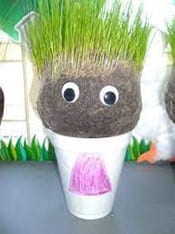Growing plants is an activity that has success happening right before your eyes! Plants need five things to grow: light, water, air, nutrients, and the proper temperature. Light is absorbed by the plant causing it to produce food that is utilized by the plant for growth. We all need food and water so make sure you are providing adequate water to the plant. Air is vital to provide carbon dioxide for making that food and making sure our environment is an acceptable temperature for growth. Most plants are not excited about frosty mornings, so covering outside plants is a must for those with flowers, bushes, and vegetables until May 15. Nutrients are the last thing that is necessary for plant growth and is typically provided in the soil and absorbed into the plant through the roots.
plants is an activity that has success happening right before your eyes! Plants need five things to grow: light, water, air, nutrients, and the proper temperature. Light is absorbed by the plant causing it to produce food that is utilized by the plant for growth. We all need food and water so make sure you are providing adequate water to the plant. Air is vital to provide carbon dioxide for making that food and making sure our environment is an acceptable temperature for growth. Most plants are not excited about frosty mornings, so covering outside plants is a must for those with flowers, bushes, and vegetables until May 15. Nutrients are the last thing that is necessary for plant growth and is typically provided in the soil and absorbed into the plant through the roots.
What is a “chia pet”? As advertised on television, chia pets are round, clay objects that grow grass resembling hair. The best part is we can give them “a haircut”, and then watch it grow to be cut again. We still need to provide all the necessary ingredients to grow our “hair” but can find many of these items around the house or at the local store.
Supplies needed: small Styrofoam cup, knee high pantyhose, potting soil, grass seed, markers, googly eyes and glue.
- Place grass seed in the bottom of the pantyhose (make sure you are covering a good section to make its head full of hair).
- Now add 1 ½ cups of potting soil on top of the seed.

- Tie the pantyhose tight around the soil, making it round like a human head.
- Decorate your cup (which is your flowerpot) and then fill it ½ full of water.
- Turn your head upside down (so extra pantyhose is hanging down) and place the pantyhose full of soil and seed in the cup.
- You can add eyes, ears, nose, etc. to make your chia pet come alive!
- The pantyhose acts as the roots of the plant. In just a few short days, your chia pet will start growing hair.
- Make sure that you provide sunlight and add water as needed to help your “hair” grow!

